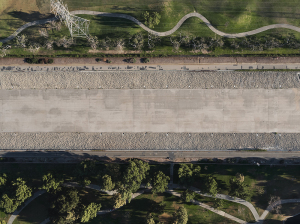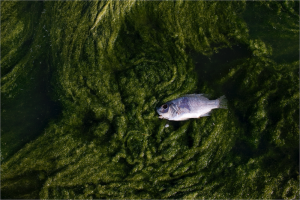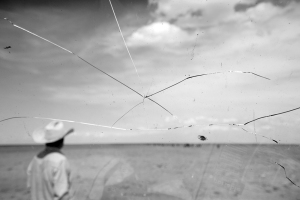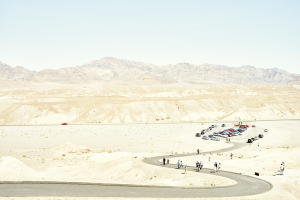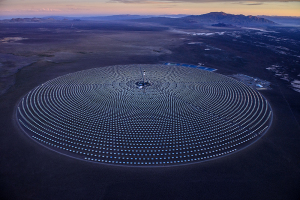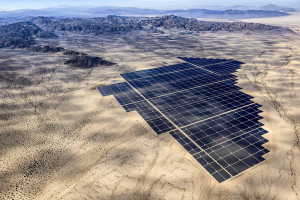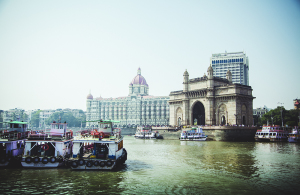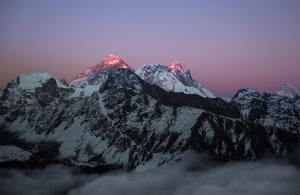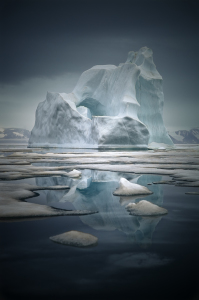
COP21 PARIS 2015
CURATORIAL STATEMENT
Photography in the hands of great artists can transmit a visual message that can make an impact, like no other medium. A single still image is capable of saying something so profound that its effect is undeniably felt by all people.
The artistic expression may be an individual one, but an image can be universally understood, and resonate around the world. The Lucie Awards is honoured to have been asked to curate and present exceptional images that do just that.
For the UN Climate Change Legacy Exhibition, we have called upon renowned photographers who have dedicated their lives to documenting melting icebergs, drought, air, water, waste pollution and the undeniable effects these things have had on our planet. It is a condensed, compassionate plea, through their lenses, of the effects of climate change.
Their images may be startlingly beautiful, which can complicate the horrific message they convey, but look beyond the amazing artistry and try to understand the subliminal ideas within these framed works.
Bravo to these brilliant image-makers who challenge us with their documentary record of what is taking place. It has been a privilege to curate their works for the COP21. We have been humbled by their clarity and consistent endeavour to keep shouting to the world to do something.
Hossein Farmani, Chair, The Lucie Awards
Susan Baraz, Co-Chair, The Lucie Awards
Andrea Bruce
Farmers Committing Suicide in India
Andhra Pradesh, India
Akhila Balamani (12) works in the cotton fields to help her mother and sister repay the debts her father left in the wake of his suicide. In 2013, the Indian government reported that over 17,000 farmers committed suicide. The effects of global warming have led to a perfect storm of hopelessness in India’s agriculture dependent society.
Andy Anderson
Oil, Kern County Oil Fields
Bakersfield, California, USA
The burning of fossil fuels – oil, coal, and gas – is driving climate change. Oil production, transport, and use have extreme impacts on the environment and create green-house gas emissions which have already warmed the globe by more than 1°C since the beginning of the Industrial Revolution.
Aristide Economopoulos
Ghosts of Hurricane Sandy
New Jersey, USA
The Princess Cottage at night, located at 705 Front Street, was severely damaged in Union Beach, NJ, because of Hurricane Sandy. As our planet gets warmer, our sea levels keep rising. More than 500 houses in the city were damaged and over 110 destroyed. A haunting silence sets in every 24 hours when the sun dips behind the horizon.
Brent Lewin
Urban Jungle
Bang Bua Thong, Thailand
An elephant scratches it’s head against the concrete foundation at an abandoned housing development in Bang Bua Thong, Thailand. The biggest threat to the Asian elephant is habitat loss due to deforestation, which is also the biggest source of carbon emissions contributing to climate change.
Bruno Tamiozzo
Agbogbloshie
Accra, Ghana
Agbogbloshie dumpsite in Ghana’s capital, Accra, is one of the main hubs for electronic waste disposal in West Africa, particularly from old computers and computer monitors. Since the late 1990s, countries around the globe have been sending millions of tons of e-waste to be processed each year on the site, which is home to more than 40,000 people.
Cameron Davidson
Aerial photograph of Mountain Top Removal in Southern West Virginia
West Virginia, USA
Mountain Top Removal in Southern Appalachia is a major contributor to global warming by making it easier to mine large quantities of coal. The environmental downsides to Mountain Top Removal include eradication of forest, run-off and placing the over-burden from the mining process into hollows and valleys.
Colin Finlay
Consumerism
Salton Sea, California, USA
The Salton Sea was formed in 1905 when the Colorado broke its banks. 130 million gallons of partially treated sewage, slaughterhouse scraps and industrial toxins are carried by the New River into the sea per day. There is so much selenium at the bottom of the sea that it would be considered a hazardous waste dump were it not covered by water.
Emmanuel Coupe-Kalomiris
Aerial Series of Icelandic Rivers
Iceland
Icelandic glaciers serve as water storage for the residents of the island. The glaciers in Iceland are vanishing, some already have disappeared and others are in the quick process of melting down forever. The southern parts of Iceland is where the glacial rivers form as they make their way to the ocean.
Emmanuel Coupe-Kalomiris
Aerial Series of Icelandic Rivers
Iceland
Water and Ice account for 80% of Iceland’s electric power, and 100% of their electricity needs come from renewable sources significantly causing less CO2 emissions. However, the fast receding glaciers that store water supply now cause serious concerns about the near and long-term impact.
Espen Rasmussen / Panos Pictures
Ukraine, Enakievo, 2010
Ukraine
The smell gets in your clothes and stays. The sun barely shines through the windows. The streets are covered in a dirty layer of ash. The 140,000 people who live in Enakievo, a city in the east of Ukraine, have grown used to their bleak surroundings. The steel plant may plague the air with smoke from its 14 chimneys, but it also provides jobs and income.
Gerd Ludwig
Baku, Azerbaijan, 1993
Azerbaijan
The burning of fossil fuels not only destroys the ozone layer, but in Azerbaijan, dilapidated and leaky pumps of oil rigs create viscous pools of runoff. With forests of rigs in their backyard, the children of suburban Baku have learned to use them as sad substitutes for missing playgrounds.
Gerd Ludwig
Aral Sea, Kazakhstan, 1993
Kazakhstan
Camels cross the dry bed of the Aral Sea. A powerful combination of irrigation draining the sea’s feeder rivers and decreasing snowfall in the Pamir Mountains has shrunk the sea’s area to the point where it has disappeared almost entirely. The area was plagued by dust storms that contained toxic residue from industrial agriculture and weapons testing in the area.
 Giles Clarke
Giles Clarke
The Recyclers of Port Au Prince
Haiti
This image represents Haiti’s desperate struggle to lift itself from the depths of misery and corruption that has plagued the country for decades. This vast landfill is owned by the government and situated directly above the Plain Cul-De-Sac aquifer – the same water that provides drinking water for the poorest neighborhoods of Port-Au-Prince.
Gorazd Golob
Power
Zambia
This photo was taken in Zambija, Kafue National Park, known as one of the parks in Africa with the most wildlife. However, on my trips from 2010 – 2015, I have witnessed a decrease in wildlife. This could be due to the electrical lines being installed, extra roads being built, and the problem of poachers. More and more animals are found killed, tusks from elephants cut and carcasses left.
Jamey Stillings
#9499, 21 March 2013
California, USA
Ivanpah Solar Power Facility, in the California Mojave Desert. A hill formation rises above the alluvial slope at the eastern boundaries of Units 2 and 3 with heliostat installation complete. In 2014 Ivanpah Solar became one of the world’s largest concentrated solar thermal power plants.
Jesper Anhede
Canoeing in the Morning Mist – Centennial Valley, Montana
Montana, USA
The Centennial looks very much as it did more than a century ago. In parts of the valley, not so much as a power line mars the view. However, climate change poses a growing threat to this crucial and fragile ecosystem – home to grizzlies, wolves, elk, deer, and other magnificent wildlife.
Joel Sartore
The Vanishing: Amphibian Extinction
California, USA
Far from civilization, mountain yellow-legged frogs high in California’s Sierra Nevada are dying in droves. The culprit: amphibian chytrid fungus. Because amphibian skin is so thin, frogs are acutely sensitive to minor changes in their environment. These changes make the frogs more susceptible to chytrid fungus, which is threatening the amphibian population world-wide.
Johannes Frank
Aurora at Mosfell Mountain
Iceland
Some say northern lights will disappear if global warming continues. Some say they are more visible due to global warming. “The fact is Auroras are associated with a high number of sunspots. This relationship has been known since 1852, when Edward Sab-ine first identified it using sunspot and aurora spotting data…. This relationship seems to also correlate with climate patterns.” (what-when-how.com)
Jon Hope
Sunrise in the Sunset
San Francisco, California, USA
The Sunset district of San Francisco epitomizes the American post-WWII housing boom. In 2016, San Francisco leads the US with aggressive climate and sustainability targets addressing renewable energy, transportation, water, green infrastructure, and waste. The city aims to reduce greenhouse gas emissions by 40 percent below 1990 levels by 2025.
Kensuke Suzuki
Lucid Dream
Japan
There are dreams in reality. When traveling around the world, I sometimes feel under the illusion that it is all a dream. The planet we live on is filled with beautiful momentary light. Hokkaido is the northernmost area of Japan, where during winter, a meter of snow sometimes falls in a day. The photograph was taken around March, just before the start of spring. Average winter temperatures in Hokkaido have increased by 1.3°C over the last century.
Kristin Lau
Nepal—A Moment of Silence
Namche Bazaar, Nepal
Namche Bazaar is the largest village in the Solukhumbu region, surrounding the epicenter of the second 7.3 magnitude earthquake that hit Nepal. Namche Bazaar is known as the main trading center for the Khumbu region. It rests at an altitude of 3,440m and is one of the main lodging villages for the intrepid Mount Everest trekkers and professional mountaineers. As the country continues to struggle with the effects of the natural disasters and political instability, renewable energy is providing both light and hope for a nation of people renowned for their resilience.
Marcin Szczepanski
From the ‘People of the River’ series
Brazil
A lone horse waddles through a flooded pasture in Pantanal, Brazil. The Pantanal is a vast wetland with a delicate ecosystem that relies on the balance of annual flooding and restrained cattle raising activities to support its massive flora and fauna. Climate warming and pollution threatens the existence of Pantanal. Roughly 80% of the Pantanal floodplains are submerged during the rainy seasons, helping to support a dense array of animal species like jaguars or caimans. 1000 bird species, 400 sh species, 300 mammalian species, 480 reptile species and over 9000 different subspecies of invertebrates make the area home.
Marie Wilkinson & Cyril Christo
Convergence of the Tribes, Amboseli, Kenya, 2007
Kenya
Convergence of the Tribes captures the convergence of humans and their livestock with a herd of elephant on a common waterhole. Around the world, humans, livestock and wildlife are increasingly coming into conflict over life-sustaining resources that are becoming threatened by effects of the changing climate. As human population expands, the fate of the elephant is called into question, as is much of the diversity of natural world. The fate of the elephant marks the fate of humankind: we are and have always been indissolubly linked.
Matthew Turley
Home Interiors, Kolmanskop, Namib Desert, Namibia
Namibia
Kolmanskop was a bustling diamond mining town in the early 20th century until it was abanadoned after WWI and the diamond crash. All of Kolmanskop’s structures became too expensive to maintain in the hash climate and by 1954 it was a ghost town. Climate change is likely to amplify the hot and dry conditions already experienced in Southern Africa.
Parker Pfister
Superior Power
USA
The Silver Bay power plant in Silver Bay, Minnesota belches out over half of a million tons of CO2 on the beautiful shores of Lake Superior every year. Minnesota is currently “answering the nation’s call,” exploring and investing in new renewable power and energy conservation options for the power plant in an effort reduce carbon emissions and mitigate climate change.
Parker Pfister
Badwater
Death Valley, California, USA
Badwater Basin is an endorheic basin in Death Valley National Park, Death Valley, Inyo County, California, noted as the lowest point in North America, with an elevation of 282 ft below sea level. It has also set the hottest air temperature in the world at 134 degrees. A newly formed lake here would not last long though, because the 1.9 in of average rainfall is overwhelmed by a 150 in annual evaporation rate. This is the greatest evaporation potential in the United States, meaning that a 12 ft lake could dry up in a single year.
Paul Souders
The Ice Bear
Svalbard, Norway
A lone polar bear sits at the edge of a melting iceberg near Half Moon Island in the Svalbard archipelago. During my first trip to these Norwegian-administered high arctic islands, I saw polar bears for the first time in the natural environment. The landscape at 80° north latitude was barren and forbidding, but also hauntingly beautiful.
Petra Barth
Aurora Borealis
Alaska, USA
The image shows the Trans Alaskan Pipeline (TAP) and the Aurora Borealis. The TAP pertains to one of the world’s largest pipeline systems. The Trans Alaskan Pipeline System’s negative environmental impacts are noted in the air quality of the area, in the vegetation and throughout the wildlife, as well as in the thawing of permafrost. This in turn increases the risk of damage to landscapes and public infrastructure, like the pipeline itself. It shows that the effects of global warming spare nothing, not even the sources that cause it.
Po Chun Huang
Melting
USA
This photo was taken in a narrow ice cave near Exit Glacier in Seward, Alaska, so narrow that I had to crawl in carefully without damaging the structure. The melting of all the glaciers on earth is speeding up due to the worsening of the global warming. The Mendenhall ice cave in Juneau, Alaska, which was once one of the most spectacular scenes in the world, has disappeared. How many other magnificent views do we have to destroy before we wake up and try our best to make a difference?
Robert Leslie
Bastrop Texas 2011 Wild Fires
Texas, USA
The region surrounding Bastrop, Texas was parched from years of diminished rainfall and many years of drought. Over the labor day weekend of 2011, high winds from tropical storm Lee caused weakened trees to fall onto power lines, creating sparks that fell onto and ignited the dry grass and leaf litter below. By October 1, the fire had reached 98% containment but had burned a total of 34,068 acres and 1,645 homes, making it the most destructive fire in Texas history. Wild fires burned an estimated 8,706,852 acres of land across the United States during 2011 making it the third-most-active wild fire season in the historical record (since 1960).
Rudi Dundas
Water is Life’s Most Basic Need
Kenya
This young Samburu girl is carrying two jerry cans of water, about 20 kilograms, every day over 5km so that her family can live in this drought parched area of NW Kenya. People in the Southern Sahara have experienced drought conditions for the past 15 years meaning that children like this young girl cannot attend school if their families are to survive. Water is life. Without it there is none.
Simon Harsent
Melt
Newfoundland
This project begins with images of the massive icebergs as they enter Greenland’s Disco Bay from the Ilulissat Icefjord; it ends with the icebergs off the East Coast of Newfoundland, by which time they have travelled hundreds of miles, and have been so battered and broken down that they are little more than ghosts of what they once were. Seeing them first overpowering in grandeur and then, later, about to be absorbed back into the flux from which they came, is both beautiful and humbling: a metamorphosis that endows them with a lifespan, each with it’s own personality, each with it’s own story.
Simon Harsent
Melt
Newfoundland
This project had its origin in a wholly personal moment; a personal journey. It is impossible, however, to look at these images and not think of the environmental issues we face right now. Just as the choice I made in my childhood in some ways de ned me as a man, so the choices we are making as a species will de ne who we become, and what becomes of the planet on which we live.
 Steve McCurry
Steve McCurry
Dust Storm in the Desert
I was in a beat-up taxi traveling through the desert to a town called Jaisalmer near the India-Pakistan border. It was June, and as hot as it gets, The rains had failed in that part of Rajasthan for 13 years. I wanted to capture something of the mood of anticipation before the monsoon. As we drove down the road, we saw a dust storm grow. Where we stopped, women were working on the road, something they have to do when crops fail. They were barely able to stand in the fierce wind, and were clustered together. In the strange dark-orange light and howling wind, battered by sand and dust they sang and prayed. Life and death seemed to hang in a precarious balance.
Tine Poppe
Not Dark Yet
Climate change is the greatest environmental, economic and social challenge that we face. It’s impacts are often not immediately noticeable, nor are the benefits of acting against it. Plants, animals and insect species are exterminated one thousand times faster than the normal rate. Scientists talk of the largest mass death since the disappearance of the dinosaurs. Time is ticking, and we need to act now.
Valerie Leonard
Praying Ganesh
Andaman Islands, India
Andaman Islands are a group of Indian Ocean archipelagic islands in the Bay of Bengal, between India to the west and Burma to the north and east. In spite of its white sand beaches lined with palm trees, this archipelago remains a confidential destination, spared by the mass tourism. The National Academy of Sciences, India suggests that while the small Islands developing states are least in their contribution to climate hazards but stand first in bearing its brunt.
Yosuke Kashiwakura
Crows Nest
Tokyo, Japan
The crows that live in Tokyo use clothes hangers to make nests. In such a large city, there are few trees, so the natural materials that crows need to make their nests are scarce. As a result, the crows occasionally take hangers from the people who live in apartments nearby, and carefully assemble them into nests. The city is part of the earth as well, and it too is remarkably impacted by climate change. Both the humans and the animals living in the city are exposed to drastic changes.
Yvonne De Rosa
Terra Mia
Campania, Italy
The Italian Region of Campania, in the last few years, it has become the center of a media storm due to the dangerous levels of pollution of the land and the connections between politics and corruption. My work observes those who are battling to live in this complex situation, placed amongst the toxic elements of contamination and corruption both literally and metaphorically.
C40 MAYORS SUMMIT MEXICO CITY 2016
BUILDING UPON THE ORIGINAL EXHIBITION OF PHOTOGRAPHS PRESENTED AT COP21 IN PARIS (DECEMBER 2015), THIS EXPANDED EXHIBITION CONTINUES TO EXPLORE THE IDEAS OF OUR GLOBAL CLIMATE IN TRANSITION.
The collective imagery aims to awe and inspire, to challenge and confront the viewer, and to provide more understanding and awareness about our environment and how it continues to evolve with our actions and choices.
We salute these photographers who are using their cameras to document the shifting climate, some of them even risking their lives in the pursuit of exposure and truth.
Cat Jimenez, Lucie Foundation
Teal Thomsen, Lucie Foundation
 Alejandro Prieto
Alejandro Prieto
Caribbean Pink Flamingos at Celestun, Yucatán, Mexico
Yucatán, Mexico
A flock walking through the Ria looking for food. Environmental changes caused by global warming are some of the biggest problems this bird is facing. Last year the main nesting area at Rio Lagartos was flooded, causing the loss of thousands of eggs. Numbers of these beautiful birds are continually decreasing through the years.
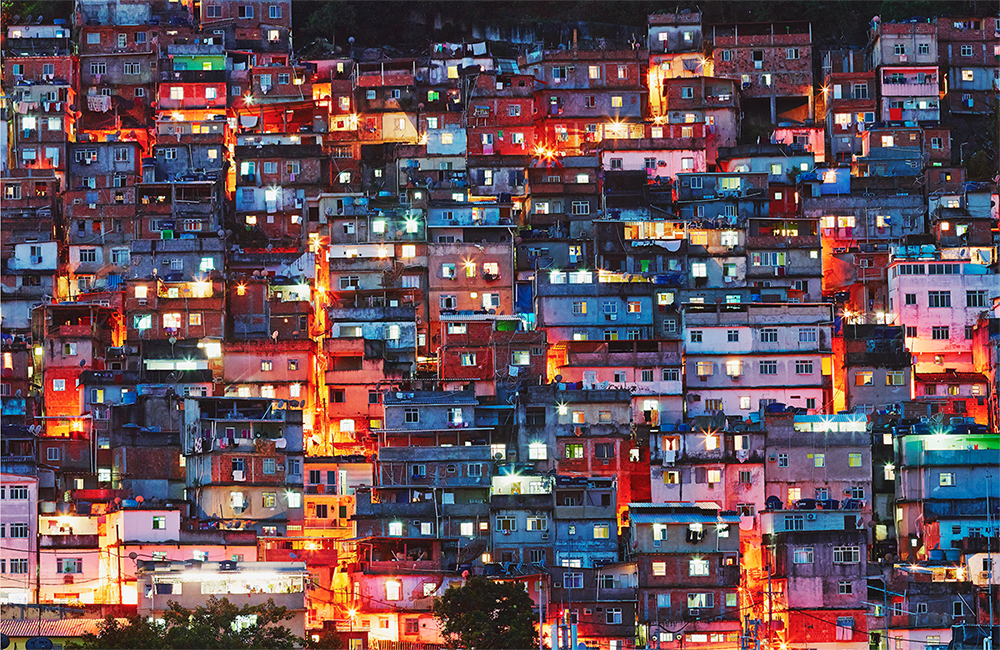 Baldemar Fierro
Baldemar Fierro
Flavela Morro do Cantagalo
Rio De Janeiro, Brazil
Morro Do Cantagalo favela, which overlooks Ipanema Beach in Rio. An estimated 20% of Rio’s population lives in the unregulated favelas that spread up the city’s hillsides. Rains and mudslides are a tremendous threat to this community. In January 2011, 1,000 people died due to flooding and mudslides that ravaged the hillside slums.
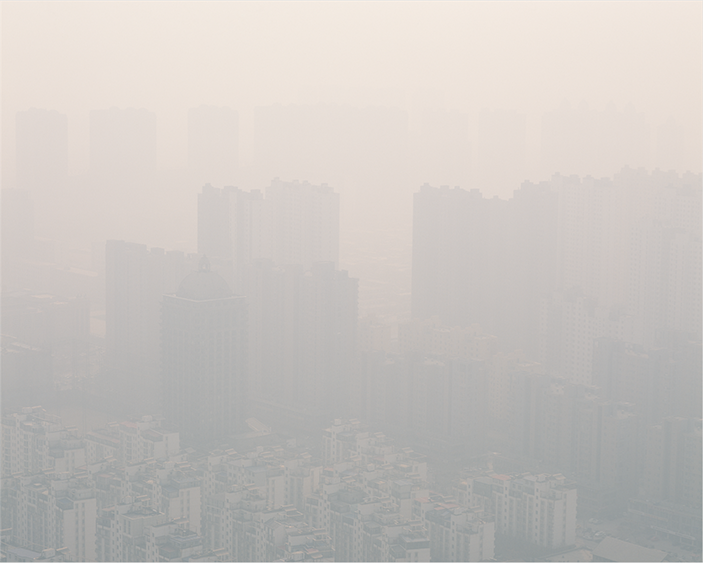 Benedikt Partenheimer
Benedikt Partenheimer
Air Quality Index 360, Particulate Matter
Shijiazhuang, China
The series deals with the relationship between revival and decline and reflects the consequences that come along with excessive economic growth and the combustion of carbon-based fuels. The work addresses an alarming degree of air pollution caused by human acts and exemplifies continuing human disturbance to the environment.
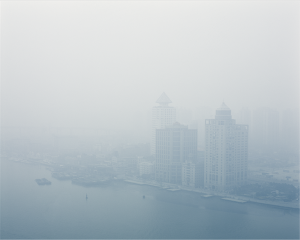 Benedikt Partenheimer
Benedikt Partenheimer
Air Quality Index 430, Particulate Matter
Shanghai, China
The image is photographed from an elevated vantage point, emphasizing the reduced visibility in a diminished toxic space. The title of the image refers to the Air Quality Index, indicating the degree of air pollution. As global warming becomes a defining context of our lives, we must renegotiate our relationship with nature and think about sustainable and future-oriented solutions.
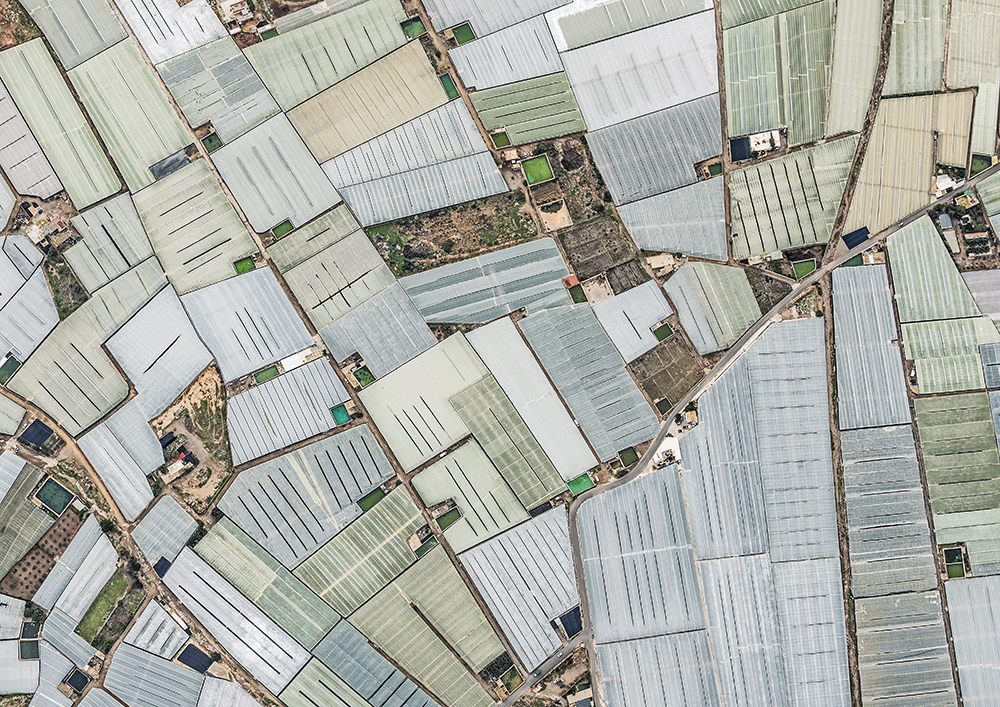 Bernhard Lang
Bernhard Lang
AERIAL VIEWS Mar del Plastico 2014
Andalusia, Spain
Aerial Photographs of the so called, “Mar del Plástico” – greenhouse farming in Andalusia, Southern Spain, the biggest zone worldwide for cultivation underneath plastic foils. The future presented by these greenhouses is not a clean eco-tech environment but instead it’s an environmental catastrophe of chemical laden food and slave-like labor.
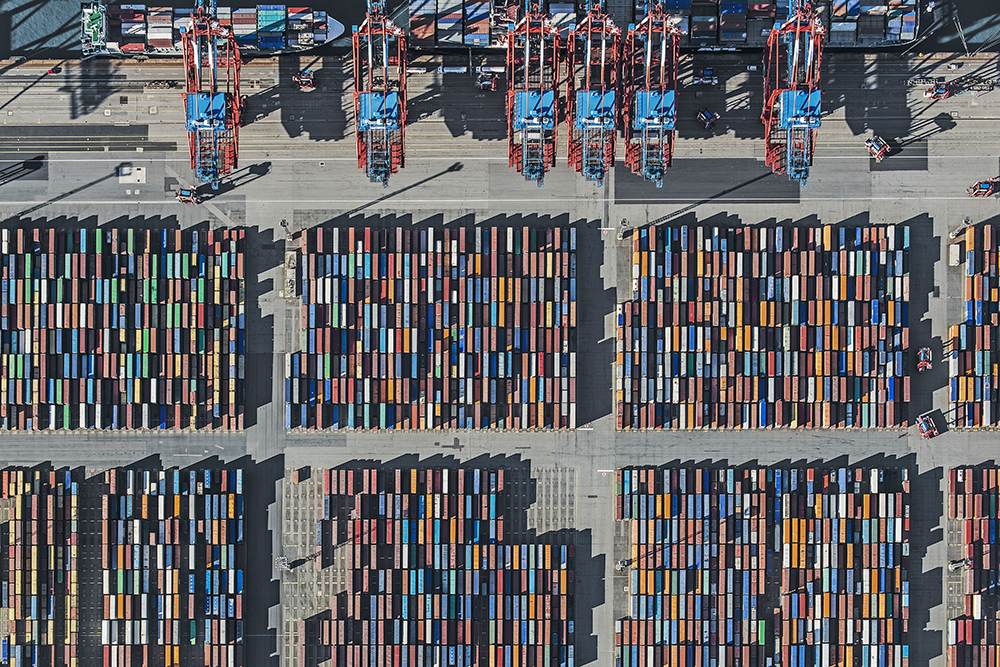 Bernhard Lang
Bernhard Lang
AERIAL VIEWS HARBOUR 2013
Germany
This image of the port at Bremerhaven show rows and rows of shipping containers during mid-shipment. Seen from above, it’s staggering to think about how much stuff people use, buy, sell and ship. These photos demonstrate the massive footprint of globalization.


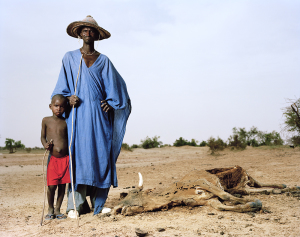 Braschler/Fischer
Braschler/Fischer
Gouro Modi (36) with his son, Dao (6)
Cow herdsman
Korientzé, Mali
We are tired, very tired because the climate has changed. Our homes are far from here. We left because there was not enough rain. We follow the pastures. We go where there is water. It used to rain a lot, but not now. When I was a child, the animals ate well, the people ate well, and everything went well. But, there’s a really big change. I’m afraid. All the breeders and shepherds are afraid. If there’s no water, we will actually have to dig so that the cows can find water to drink. Our hope is that the water doesn’t disappear right away. We pray for the water to come so that the animals can find food to eat.
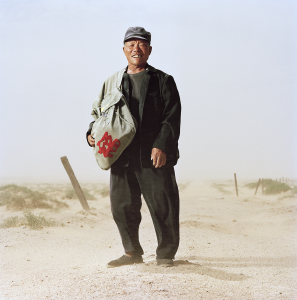 Braschler/Fischer
Braschler/Fischer
Chai Erquan (65)
Farmer / Shepherd
Hongsheng, Gansu, China
There are many sandstorms in this area. Sometimes they are so bad that I can hardly see in front of my eyes and so the sheep scatter everywhere. When I was little, we had a lot of rain. We did not have any reservoirs, because we did not need any. There was rain, water, and streams all around. But now, we count on the irrigation pipes. I think it has been getting hotter and hotter. In the nineties it got really bad. Now we can barely raise sheep here. It has hardly rained at all this year. Soon, I think this place will not have any water left. Before, our wells only needed to be thirty to forty meters deep. Today, we drill three hundred meters but the water is still scarce. There is no drinking water left where I live. You try very hard to get half a cup, maybe.
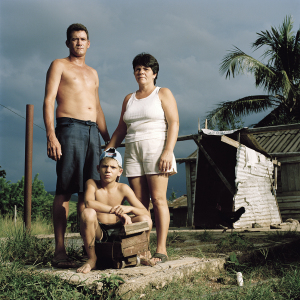 Braschler/Fischer
Braschler/Fischer
Yusnovil Sosa Martínez (33), with his wife, Antonia González Contino (41), and her son, Yosdany Miranda González (10)
Public health worker
Sanguily, Pinar del Rio, Cuba
We had just started repairing the damage from one hurricane (Gustav) when the second one (Ike) hit. We didn’t have time to do anything. The first cyclone was incredible. It was bigger than we expected. In this municipality, we had only experienced small hurricanes before. Now they come more frequently. Before we had one hurricane a year, now there are two or three. You have to live through one to know what it feels like; it is a total disaster. You go out and see one thing and then, when you go out again, you do not see that anymore, it’s all gone. The hurricanes are stronger now because the atmosphere is more charged. We have all contributed to global warming and we must try to do something about it or there will be more disasters. It might not be us who suffer, but if measures are not taken, then perhaps our children will have problems with the warming of the atmosphere.
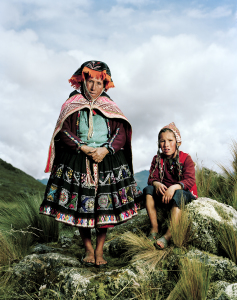 Braschler/Fischer
Braschler/Fischer
Gomercinda Sutta Illa (54) and her grandson, Richar Guerra Sutta (10) Farmers
Chahuaytire, Peru
We are worried that we may not have enough food. The snow came at the wrong time of year and ruined our potato crop. Beans and oats were also damaged, but potatoes were affected the worst. Those that survived the snow are owering at the wrong time. They are diseased. The harvest won’t be good. The weather is unpredictable. The last few years have been too hot, which affects the land, and the rain falls during the wrong seasons. I am worried for my children. They will face many problems when they grow up.
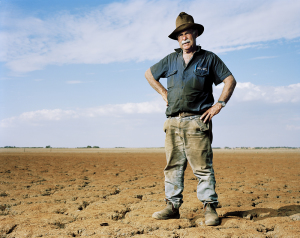 Braschler/Fischer
Braschler/Fischer
Michael Fischer (60)
Dairy farmer
MeningieWest, South Australia, Australia
I’ve built this place up over thirty-eight years. We were very successful with a six hundred-cow dairy. But fourteen months ago, we had to dispense with the dairy because there was just no water. We are seeing extreme heat. I was convinced that the rains will come and we’ll be back in business again. But the next year we had restrictions again, and the water was getting very saline. We had a lovely little golf club. That’s gonna go. They’ve got to buy the water back, but they won’t step in the market and buy big. It’s political and it shouldn’t be. The (Shire of) Murray is the fruit bowl of Australia. But there’s not gonna be very much of it shortly because the water is running very low.
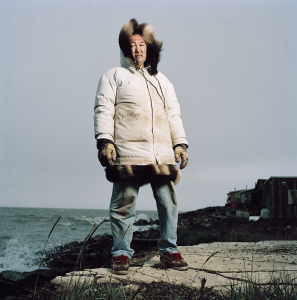 Braschler/Fischer
Braschler/Fischer
Sandy Adam (55)
Inuvialuit whaler / hunter
Tuktoyaktuk, Northwest Territories, Canada
My house is at risk. I do not know how long it can last here, perhaps ten years and then it will be gone. You can see how much the land has eroded. The beach used to be a thousand feet over there. Underneath us is just permafrost, and it is all going to melt away. As soon as it gets any warmer we will sink. My son lives in Calgary now and last year he came for a visit and he saw a lot of changes and he said, “Oh my goodness, mom, you guys are going to be swimming in the water pretty soon.” We will move to higher ground at Reindeer Point, but the land is eroding over there, too. It is the same all over the place. It’s getting warmer. The snow does not get hard anymore, it is like sugar. When we were young, we would get excited if we saw an iceberg. But now more of them come in from the breaking ice.
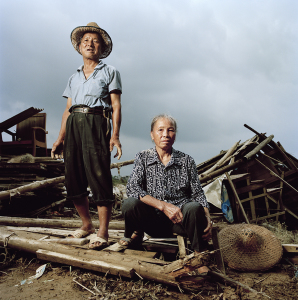 Braschler/Fischer
Braschler/Fischer
Yang Gengbao (69) and his wife, Huang Lianfeng (68)
Shop owners and flood victims, by their home destroyed by flood
Hongse, Guangxi, China
The rainstorms are heavier than those we had before. The three biggest oods in my life have taken place over the last twenty years. The latest was the worst after the ones in 1996 and 1988. The waters rose very quickly. Before we had time to move anything, it was on our doorstep. When we returned two days later, all our possessions had been soaked or carried off by the waters. Our trinket shop is ruined, so we have no income. Life has become tougher but we cannot do anything. We just have to bear it. The floods always come and even if they come more often, we will stay. We have been here ten years. We don’t actually like living here, but we do it for survival. We need to make money for food. Where else could we go?
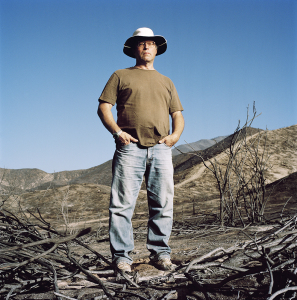 Braschler/Fischer
Braschler/Fischer
John Glance (55), standing on land right behind his house, burned by the “Station Fire” in September 2009
Musician
Acton, California, United States
The fire took out some fences. It took out some poles, some irrigation. It jumped over the barns, lit the pastures alight on both sides, and came round one side of the pastures. We were lucky we survived. The winds blew in our favor at the last second. The cause hasn’t been determined. There are fires in California pretty much every year. It’s inevitable, but not usually at this time. It seems that the seasons are changing, you know, summer stays longer, comes later. Same with the winter—seems to come later and stays longer. We are definitely in a drought, that’s for sure. I can’t imagine there isn’t something happening; it seems that things are getting slightly warmer; it seems that the seasons have changed and there seems to be scientific evidence to back it up. The number of us and what we are doing with our cars—I mean, check out an L.A. freeway on any Monday morning—there is no earthly way that it’s not having repercussions, and this is happening all over the United States, and presumably all over the world.
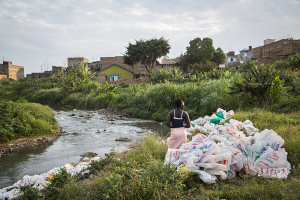 Carolyn Monastra
Carolyn Monastra
Woman Collecting and Cleaning Plastic bags by the Nairobi River
Kenya
This woman regularly collects discarded plastic bags around her community near the Nairobi River. After cleaning them, she sells some of the bags to stores to reuse and keeps others to crochet products such as handbags and hats. This woman is reducing her community’s carbon footprint by reusing existing bags as well as creating income for herself.
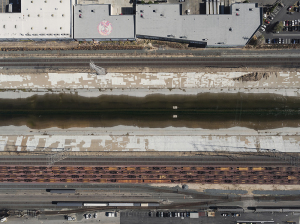 Chang Kyun Kim
Chang Kyun Kim
Los Angeles River from above #01, 2016
Los Angeles, USA
This is an industrial area near Downtown LA where the most toxic discharge is transported. After years of serious drought in California, the amount of water in the river has been significantly reduced, worsening the chemical odor through the river.
 Chang Kyun Kim
Chang Kyun Kim
Los Angeles River from above #05, 2015
Los Angeles, USA
This is the center channel that was designed to promptly send out rainwater to the ocean. It is said that if the water from only one day of rainstorm can be saved and managed through the river, much part of water scarcity issues in Los Angeles can be resolved.
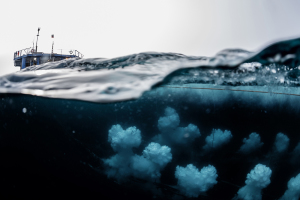 Christian Aslund
Christian Aslund
Dead End – Oil Exploration in the Arctic
Arctic
Underwater image of a ship conducting seismic blasting off northeast Greenland in order to find possible oil reservoirs. Above water, this sound intensity would be perceived by humans as approximately eight times louder than a jet engine taking off. According to a new scientific review, seismic blasting is ‘alarming’ and could seriously injure marine life in the Arctic.
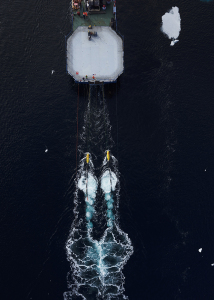 Christian Aslund
Christian Aslund
Dead End – Oil Exploration in the Arctic
Arctic
Norwegian company TGS Nopec conducting seismic blasting off northeast Greenland, ring airguns that emit 259 decibel blasts towards the seabed in order to find possible oil reservoirs. Above water, this sound intensity would be perceived by humans as approximately eight times louder than a jet engine taking off. Global oil companies including BP, Chevron and Royal Dutch Shell all own drilling rights in the Greenland Sea and are the likely customers for the data uncovered by the seismic testing company.
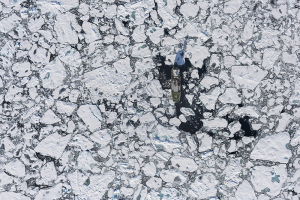 Christian Aslund
Christian Aslund
Dead End – Oil Exploration in the Arctic
Arctic
Greenpeace ship the Arctic Sunrise in the Arctic pack ice off the northeast coast of Greenland. Greenpeace is working in the area to highlight the exploration by the oil companies. Temperatures rise faster in the Arctic than anywhere else, yet despite warnings, the oil industry regards the decline of sea ice as a new business opportunity.
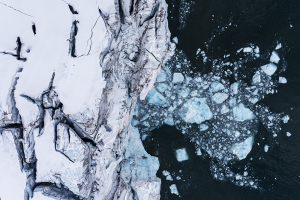 Christian Aslund
Christian Aslund
Dead End – Oil Exploration in the Arctic
Arctic
Aerial view of glacier calving at Scoresby Sund fjord, east coast of Greenland. Positioned in the Arctic, Greenland is especially vulnerable to climate change and has experienced record melting in recent years and is likely to contribute substantially to sea level rise as well as to possible changes in ocean circulation in the future.
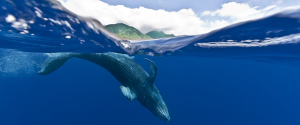 Cesere Brothers
Cesere Brothers
Maui Keiki
Hawaii, USA
The state of our climate and health of our oceans are directly linked. Our oceans absorb carbon dioxide from the atmosphere, so as carbon dioxide levels rise, our oceans become more acidic, threatening life in our oceans at every level. For young humpback whales, the vital food resources they depend on can’t survive in an acidic ocean.
This image was captured during research activities pursuant to NMFS Permit # 10018
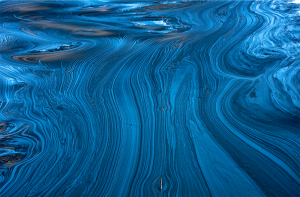 Colin Finlay
Colin Finlay
Billion gallon tailing pong at the Tar Sands
Alberta, Canada
The tar sands’ toxic ponds grow by 720,000 gallons each day and are leaking dangerous chemicals into the soil and water. If expansion is not sharply curtailed, toxic Tar Sands developments with the permits already approved, will expand to an area the size of Florida.
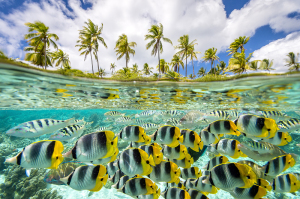 Dana Allen
Dana Allen
School is Out
Tahiti French Polynesia
A school of Pacific Double-saddle Butterfly fish (Chaetodon ulietensis) along with many other aquatic species rush by in a flurry of activity in Le Taha’a’s lagoon. Rising sea levels are an eminent threat to small islands in the Pacific like Taha’s Island in French Polynesia.
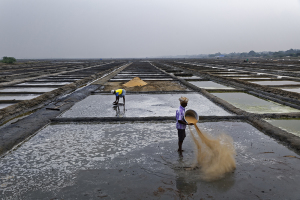 Ed Kashi
Ed Kashi
CKDnT in India: Laborers prepare the Marakannam saltpan fields for salt harvest near Pondicherry, India, on January 21, 2016.
India
Chronic kidney disease, or CKD, is a scourge of the rich world generally caused by diabetes, high blood pressure or obesity. An alternative form of CKD however, is finding it’s way into the developing world. Known as chronic kidney disease of non-traditional causes, or CKDnT, victims are mainly agricultural workers, low wage earners and rural folk.
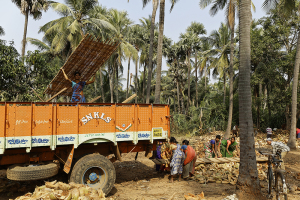 Ed Kashi
Ed Kashi
CKDnT in India: CKDnT positive laborers work on a coconut farm in the village of Pedda Srirampuram, India, on January 25, 2016.
India
This growing epidemic is thought to be occupational and environmental, not lifestyle caused, and it’s creating an alarming new medical problem that doctors around the world are barely aware of, have not figured out the cause of or found a way to prevent it.
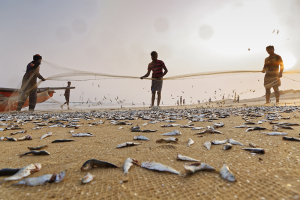 Ed Kashi
Ed Kashi
CKDnT in India: Fishermen lay out a net on the beach, with the Indian Ocean behind, near the village of Balliputtuga, India, on January 27, 2016.
India
In Central America alone, more than 20,000 people have died or contracted this illness over the past two decades. Many similar cases in other countries like India, Sri Lanka, Costa Rica, and more have highlighted the fact that this is a global epidemic. I recently traveled with a team of researchers to the states of Andhra Pradesh and Tamil Nadu, to investigate if this illness is occurring there.
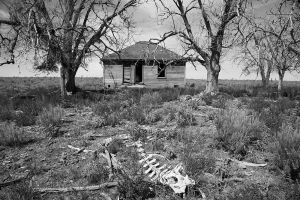 Ed Kashi
Ed Kashi
It’ll Be Better Next Year: A bleached out skeleton lies before an abandoned home on drought stricken and blighted pasture lands near Felt, Oklahoma, on July 29, 2013.
Oklahoma, USA
Along with Ashley Gilbertson, Ed Kashi documented small farming communities in and around the western tip of the Oklahoma Panhandle and their current struggle against the worst drought the region has seen in fifty years.
It’ll Be Better Next Year: A cracked glass pane reflects the drought stricken landscape as Manny Encinias, 39, looks out over his herd of cattle in Clayton, New Mexico, on July 29, 2013.
Oklahoma, USA
Located in the area of the Dust Bowl of the 1930s, towns like Clayton, NM, Dalhart, TX, Campo, CO, and all of Cimarron County, OK face the same battle pitting Mother Nature against the agricultural livelihood that has been fought by generations and generations of farmers.
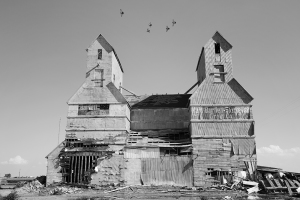 Ed Kashi
Ed Kashi
It’ll Be Better Next Year: The Bartlett Grain Company lies abandoned and neglected in Boise City, Oklahoma, on July 30, 2013.
Oklahoma, USA
As community members anxiously wait for rain, they hold onto hope and continue persevering through the hard times. Despite their future livelihood teetering on fickle weather forecasts, these small towns band together in an unbending sense of community, helping each other to maintain an optimistic outlook for tomorrow.
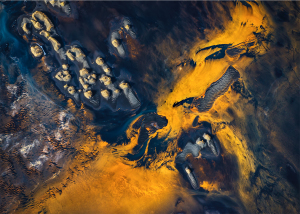 Emmanuel Coupe-Kalomiris
Emmanuel Coupe-Kalomiris
Aerial Series of Icelandic Rivers
Iceland
Iceland is a prime example of how natural elements shape the landscape. A succession of events leads to the phenomenal river system in the southern dark sand and stone plains that in return are constantly reshaping the land beneath. Glacial rivers generate hydropower that provides most of the country’s electricity.
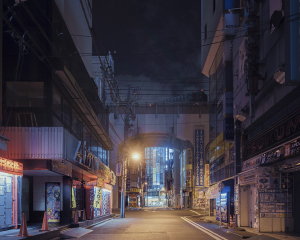 Franck Bohbot
Franck Bohbot
Akihabara, Tokyo, Japan, June, 2015
Tokyo, Japan
Tokyo Murmurings immerses us in the Japanese capital as it sleeps deeply but isn’t drowned in darkness nor lost in silence. Since the 1960’s Japan has significantly cut the amount of air pollution it produces without compromising it’s growth. According to the World Health Organization, today Japan’s cities are among the least polluted.
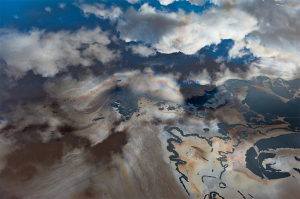 Garth Lenz
Garth Lenz
Tailings Pond Abstract #2, Northern Alberta, Canada, 2010
Canada
So large are the Alberta Tar Sands tailings ponds that they can be seen from space. Disguised by the beauty of a reflection, these toxic tailings ponds are a considerable health risk. It has been estimated by Natural Resources Canada that the industry to date has produced enough toxic waste to fill a canal 32 feet deep by 65 feet wide, stretching a distance of over 2,000 miles.
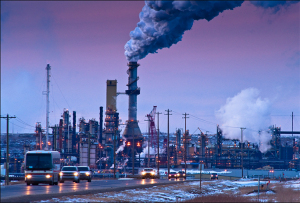 Garth Lenz
Garth Lenz
Highway to Hell
Canada
Highway 63 leads directly to the heart of the Alberta Tar Sands and through the center of one of Syncrude’s operations. Choked full of exhausted oil workers driving at break-neck speed, and contending with massive transport trucks and machinery, the highway is particularly dangerous. Virtually every week, an automobile accident on the highway kills or maims another worker.
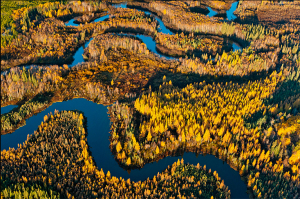 Garth Lenz
Garth Lenz
Boreal Forest and Wetland, Athabasca Delta
Canada
Located just 70 miles downstream from the Alberta Tar Sands, the Athabasca Delta is one of the world’s largest freshwater deltas. It is a critical stopover for migrating water-fowl and considered one of the most globally significant wetlands. It is threatened both by the massive water consumption of the tar sands and its toxic and leaching tailings ponds.
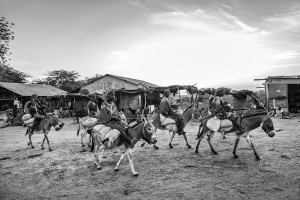 Giorgio Bianchi
Giorgio Bianchi
A Fistful of Gold
Burkina Faso, Sahel Region
A group of female workers on their way to the mine sites. Both women and children are often used as water bearers. The landscape of Yabonsgo in Burkina Faso, a community in the north-west African country, is suffering considerable environmental damages because of the increase in gold mining. Vast expanses of farm land have been illegally cleared, major water sources polluted and the livelihoods of those relying on subsistence farming left in danger.
 Giorgio Bianchi
Giorgio Bianchi
A Fistful of Gold
Burkina Faso, Sahel Region
A young miner inside a pit. Mine galleries, mostly vertical, go down 70/80 meters. In order to reach their “work station,” miners climb down using hands and feet. Considering the lack of safety measures, accidents happen daily and are sometimes fatal. So much land has been cleared that mine managers travel up to 30km to find the wood they need to stabilize the walls of the mines, building shelters, and cook.
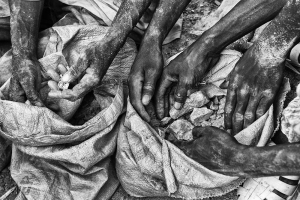 Giorgio Bianchi
Giorgio Bianchi
A Fistful of Gold
Burkina Faso, Sahel Region
Miners checking the content of a sack just brought back from the mine. The miners descend into the dark pit, digging by hands and by pickaxe, and send up the broken ore into bags of about 30kg. On top of the massive deforestation put in place to access more mine sites, many polluting substances, such as cyanide and mercury, are introduced in the environment during the gold purification process.
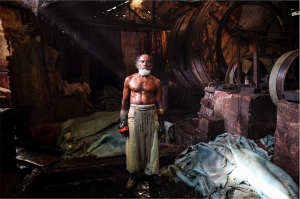 GMB Akash
GMB Akash
Hell for Leather – A worker at a tannery.
Dhaka, Bangladesh
Everyday these factories discharge thousands of liters of foul-smelling liquid waste into the river. However, with almost one billion USD a year in export sales, there has been limited progress in cleaning it up. For 60 years of operations an unrecorded amount of dangerous chemicals have been discharged into the river.
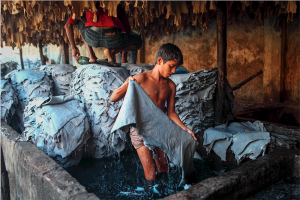 GMB Akash
GMB Akash
Hell for Leather – A young boy, knee deep in a dye vat, moves hides at a tannery.
Dhaka, Bangladesh
Almost all of Bangladesh’s 200 plus tanneries are concentrated in Hazaribagh, a neighborhood on the banks of the Buriganga River. Residents of Hazaribagh’s slums complain of dire illnesses. They blame the tanneries for the pollution causing their afflictions. The lives of the tannery industry’s estimated 20,000 workers are harsh, with many dying before they turn 50.
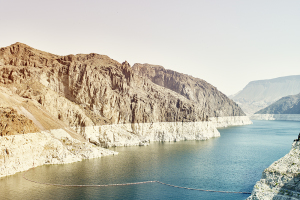 Gü Shiyin
Gü Shiyin
Not our problem
USA
Colorado river witnessed in spring 2015 at Hoover Dam, Arizona, United States. Colorado River has been running dry for the past decade, as the bathtub rings show. Yet, as shown in the picture, water still ows plenty. The problem could be around the last bend; it could be right after the end of this frame. As long as it is not in front of us, it is not our problem.
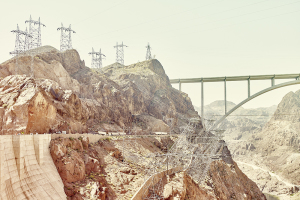 Gü Shiyin
Gü Shiyin
Conquer, we must
USA
Pylons piling over one another on the steep hillside at Hoover Dam, Nevada, United States, April 2015. We can’t imagine one day our smart phones won’t turn on, and we are prepared to obliterate our planet so everyone can turn on devices, go places, and enjoy a long, good, consuming life. It is the only promise that we haven’t failed to deliver, so long as you pay.
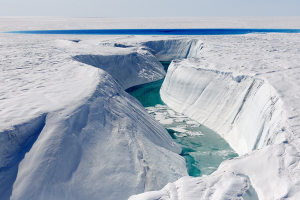 James Balog
James Balog
Birthday Canyon, Greenland Ice Sheet, Greenland, 29 June 2009
Greenland
This meltwater was created by warm summer temperatures on the surface of the ice sheet. The water eventually ows into moulins, or stream channels, that drill their way down through the ice. This meltwater lubricates the bed of the ice sheet and makes its ice ow faster into the sea.
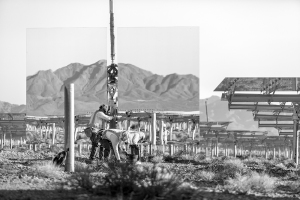 Jamey Stillings
Jamey Stillings
#7626, 4 June 2012
California, USA
Ivanpah Solar Power Facility, in the California Mojave Desert. Workers install a heliostat for Unit 1 with mountains reflected in its mirrors. Ivanpah Solar is making a compelling physical statement about our collective ability to shift from a society based on fossil fuels to one that embraces renewable energy production.
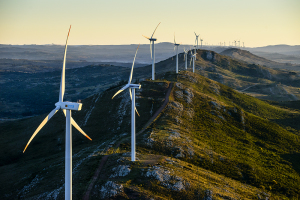 Jamey Stillings
Jamey Stillings
#4531, 9 August 2014
Uruguay
Wind Farm, Uruguay. According to World Resources Institute, the developing nation of Uruguay went from having virtually no wind generation in 2007 to become a double world-record holder in less than a decade. By 2013, it was receiving the largest share of clean energy investment as a percentage of GDP, and in 2014, installed the most wind per capita of any country.
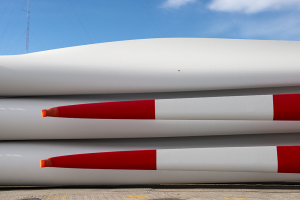 Jamey Stillings
Jamey Stillings
#7368, 11 August 2014
Uruguay
Wind turbine blades, Uruguay. As stated by World Resources Institute, by mid-2015, Uruguay installed 581 megawatts (MW) of wind capacity, providing an average 17 percent of total electricity generation over the year. Wind energy is now cost competitive in the nation, and is displacing the most expensive fossil-fuel generation.
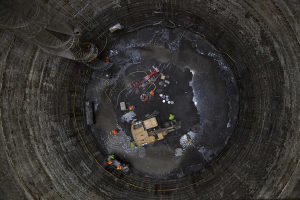 Janet Jarman
Janet Jarman
Aguas Negras: Mexico City’s Water Problems
Mexico City, Mexico
Workers excavate inside one of 24 shafts (ranging from 26 to 150 meters deep), that form part of the Tunél Emisor Oriente (“TEO”), one of Mexico’s most challenging water infrastructure projects in recent decades. To guarantee its sustainability, Mexico City needs to solve many critical water crises, including both frequent floods and the depletion of its water sources.
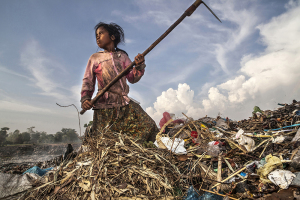 Javier Sánchez-Monge Escardó
Javier Sánchez-Monge Escardó
My Childhood as a Scavenger
Siem Reap, Cambodia
As an airplane crosses the sky, Chakriya raises her head to look and take a small break from her intense scavenging task. From her waist hangs a sack, and inside it she has been stacking cans and plastic bottles, which are easy and fast to sell. With maximum temperatures on the rise, many waster pickers prefer to work at night, making it impossible to attend school the next morning.
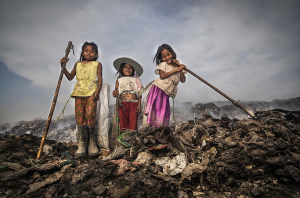 Javier Sánchez-Monge Escardó
Javier Sánchez-Monge Escardó
Three Little Scavengers
Siem Reap, Cambodia
Having the privilege of being able to attend school at a local NGO, these three little girls had just arrived to the slums where they live and went directly to try to earn some extra income for their families at the nearby dumpsite. On a daily basis, they face illnesses, aid their families, struggle to survive with scavenging, and often obtain their food from the waste.
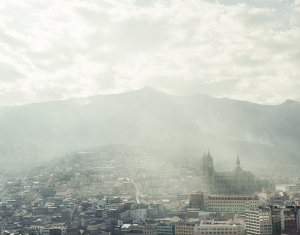 Joao Canzonai
Joao Canzonai
Quito, Ecuador, 2012
We drove to a high point with a magnificent view of the city. I didn’t want to leave the spot. I felt like I wanted to shoot the view again and again; I was transfixed by what I saw. It looked as if the city was burning (I still remember the smell of smoke). But these weren’t accidental fires or buildings burning. Instead, these were fires that were started by locals, efforts to get rid of their trash or their yard waste.
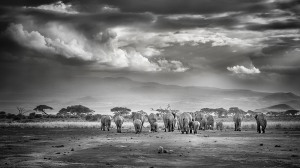 Karen Lunney
Karen Lunney
Elephant Herd – Amboseli, Kenya
Kenya
In deep history, the plains of Eastern Africa have always supported a profusion of animals on which early humans could rely. Today, major migrations such as wildebeest and elephants are significant income-earners. Recently, frequent failures in seasonal rain, increased tourism, and the growing needs of local communities are producing many con icts in land use.
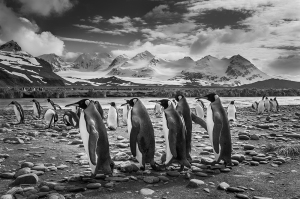 Karen Lunney
Karen Lunney
Best Foot Forward
Salisbury Plain, USA
Half a million mating pairs of King penguins live and breed on Salisbury Plain; The pictured King penguins have been at sea all day feeding and have returned to feed their young. Any overall movement in these ocean frontal zones can have significant effects in their hunting efficiency. Increasing frequency of heatwaves and torrential rainfall have had notable effects on the mortality of penguin chicks.
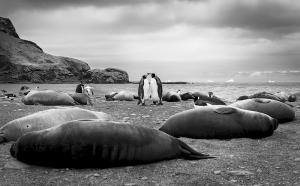 Karen Lunney
Karen Lunney
On the Beach
St Andrew’s Bay, South Georgia, USA
Polar regions are generally warming 2-3 times faster than most other parts of the world. The spatial extent and thickness of sea ice have strong impacts and feedbacks on the world’s weather. In sub-polar regions, conditions are changing at the pivotal chokepoints where the exchange of seawater between the surface layer and deep ocean is strong, and where fish and krill concentrations provide a feedstock for many species and communities. Penguins, seals and migratory birds all must now respond to various and rapid alterations to their surroundings: including changes in feeding, foraging, resting and breeding activity.
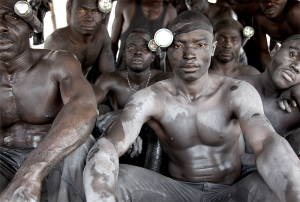 Lisa Kristine
Lisa Kristine
Price of Gold
Ghana
These boys and men are all enslaved in illegal gold mining in Ghana. They are trapped by illegal, fictitious debt, and are often hunted by local police and private security guards for trespassing. There is a direct connection between modern day slavery and climate change. According to Kevin Bales, author of “Blood and Earth”, in Ghana slaves are forced to dig for gold in protected forests, and in doing so saturate the eco-system with mercury, a poison and pollutant so potent that the land, plants, insects, animals and people living there will be a ected for decades to come.
 Luke Massey
Luke Massey
Peregrine on a condo balcony in Chicago
Chicago, USA
Peregrine Falcons nearly went extinct in the US in the 1960s due to thinning of their eggshells caused by the pesticide DDT. Peregrines began to be reintroduced into the state of Illinois in the 1980s and now 22 pairs nest in Chicago alone.
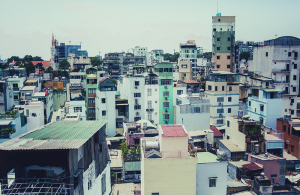 Marianna Jamadi
Marianna Jamadi
Ho Chi Minh, Vietnam
Hotel views from District 1 in Ho Chi Minh City, Vietnam. Smoggy skies and pastel buildings make for muted cubicle palette. Ho Chi Minh City, which sits on the banks of the Saigon River and is home to more than 7 million residents, ranks among the top 10 cities in the world with populations most likely to be severely a ected by climate change. According to Asian Pacific Adaptation Network, by 2050, millions of its citizens will be at increased risk from regular and extreme climatic events such as floods, droughts, and tropical storms.
 Marianna Jamadi
Marianna Jamadi
Mumbai, India
A couple enjoys a private moment under the shelter of their umbrella on Marine Drive, lining the Arabian Sea. Air pollution in Mumbai is a serious and growing issue with the major sources such as the burning of fuelwood and biomass, fuel adulteration, vehicle emission and traffic congestion. According to the World Health Organization, Mumbai is the fifth most polluted megacity in the world.
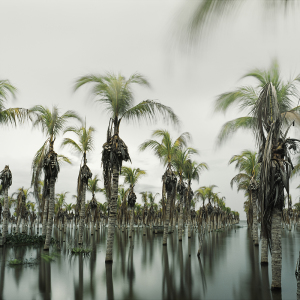 Markus Renner
Markus Renner
Flooded Palm Trees, Nicaragua 2012
Nicaragua
Nicaragua is the largest country in Central America and is a biodiversity hotspot making it susceptible to hurricanes and other natural hazards including earthquakes, volcanic eruption, and landslides. According to UNDP Climate Change Adaptation, it is predicted that climate change will result in an increase in the frequency and severity of natural disasters making Nicaragua highly vulnerable to the e ects of climate change.
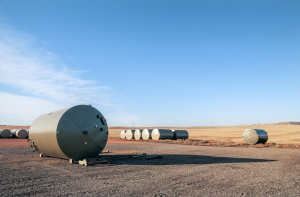 Meghan Kirkwood
Meghan Kirkwood
Oil in a Shifting Ground
USA
The impacts of global climate change will be felt differently throughout the world. In the oil-producing Bakken region in North Dakota over a million barrels are produced each day and transported outside the state via vast pipeline and rail networks. The extraction of this oil may not have an immediate impact on the earth’s climate, but globally, the burning of North Dakota crude will have signi cant repercussions for global carbon concentrations. This photograph reflects on the lingering presence of oil on the landscape and weight it bears on the future of other natural resources.
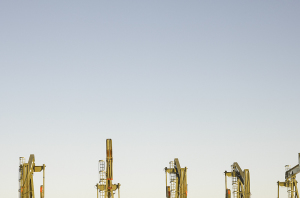 Morgan Rachel Levy
Morgan Rachel Levy
As Soft As the Earth Is
USA
Several oil well pumpjacks on the Fort Berthold Indian Reservation in North Dakota where fracking has significantly impacted the landscape and social fabric of the community. Leakage of natural gas from drilling and pipework means more methane is entering the atmosphere.
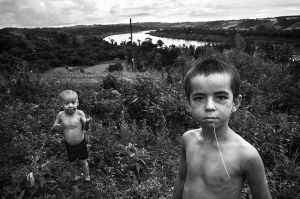 Pablo Ernesto Piovano
Pablo Ernesto Piovano
Alicia Baja- Colonia Aurora, Province of Misiones
Argentina
Lucas Techeira is 5 years old and has an incurable disease called Lamellar Ichthyosis caused by a genetic mutation. Misiones province was the gate of the transgenic crops in Argentina. The Argentinian Government authorized the use since 1996 based only on Monsanto’s studies. Based on a recent investigation (2011-2012) we can say that the Paraná River is contaminated with glyphosate, also the increase of the use of agrotoxines generated in the land an impermeable layer producing the desertification of the area increasing the volume of the river and causing floods.
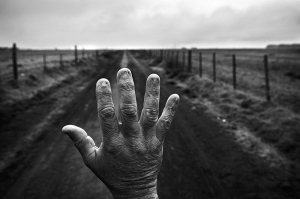 Pablo Ernesto Piovano
Pablo Ernesto Piovano
Monte Maiz, province of Cordoba, Argentina
Argentina
Alfredo Cerán worked for nine years as a ground crop-duster applying agrochemicals in soybean elds. His fingernail matrices burned. His medical blood tests for agro-chemicals showed residues of glyphosate, Clorpiritos, Azatrine, 2.4-D and Ciper-metrina. In 2015, 320 million liters (84 US million gallons) of agrotoxins were used over 24,5 million hectares. According to the information of the crop-sprayed towns, in Argentina 13.4 million people are affected. In addition to human health, the undesirable side effects of these chemicals on biodiversity as well as the environment are a growing concern.
 Palani Mohan
Palani Mohan
Hunting with Eagles
Mongolia
The hunters I met over the years often spoke about how there are less Eagles to be found in that part of the world. They say there are fewer eagles now making their nests around the mountains. The winter months are getting shorter and they believe that is one of the main reasons the eagle and fox numbers are getting lower.
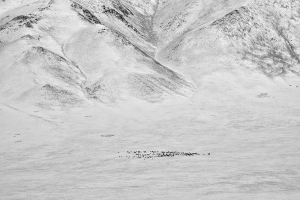 Palani Mohan
Palani Mohan
Hunting with Eagles
Mongolia
In the edge of western Mongolia the winters are getting warmer and shorter. Many of the older Eagle hunters I spend time with over the four years often take about this very thing.
As one of the hunters said “This is a hard land, a big land with very few people and a lot of space. The environment has changed compared to how it was in my child-hood. The winters used to be a lot colder and longer, some thing is happening to the land out there”
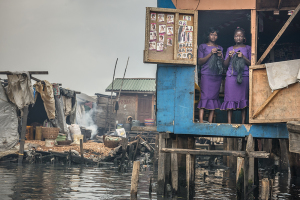 Petrut Calinescu
Petrut Calinescu
The Floating Nightmares of Makoko
Lagos, Nigeria
Two women holding weaves, stand in the doorway of a hair and beauty saloon, one of several such waterside establishments in Makoko. The Makoko slum is a 200 year old sherman community, under threat from eviction, built over the polluted waters of the Lagos Lagoon. Sea level rise and ocean surge are the major potential impacts of climate change in rapidly growing Lagos and will directly impact the Makoko community.
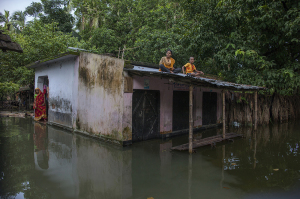 Probal Rashid
Probal Rashid
Climate Change Effects: Factual Condition of the Coast of Bangladesh
Bangladesh
A family trapped by the flood water at Tala in Satkhira. Bangladesh is one of the countries most vulnerable to the effects of climate change. The regular and severe natural hazards that Bangladesh already suffers from – tropical cyclones, river erosion, food, landslides and drought – are all set to increase in intensity and frequency as a result of climate change.
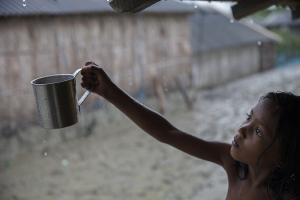 Probal Rashid
Probal Rashid
Climate Change E ects: Factual Condition of the Coast of Bangladesh
Bangladesh
Rani (9), collects rainwater for drinking. Rainwater is the main source of drinking water in the village of Shyamnagar. Sea level rise will increasingly inundate coastal land in Bangladesh and dramatic coastal and river erosion will destroy lands and homes. These and the many other adverse e ects of climate change will severely impact the economy and development of the country.
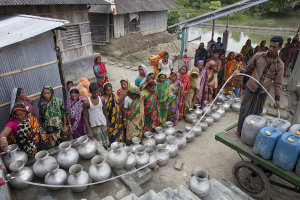 Probal Rashid
Probal Rashid
Climate Change Effects: Factual Condition of the Coast of Bangladesh
Bangladesh
Costal people gather to collect drinking water from a costly Reverse-Osmosis Plant set up by a local NGO at Burigoalini village in Satkhira. Due to sea-level rising resulting from climate change, limited water sources of the coastal area have widely been contaminated with saline water, thus compels the distant inhabitants concentrating on such limited drinking water-sources.
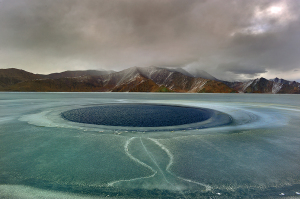 Sankar Sridhar
Sankar Sridhar
Cobalt, Jade and Gold
Ladakh, India
This image is part of a series of images that document the terrestrial metamorphosis that Ladakh witnesses through the seasons. Ladakh, a cold desert in the northernmost tip of India at an average altitude of 4,300 meters above sea level, depends on precipitation and snow for life to flourish in the warmer months. The pastoral populations pray for snow that, in summer would melt and make the grasses grow and their livestock stay healthy. While the image bears witness to the arctic temperatures that grips Ladakh in Winter – this is the 144km long Pangong lake – the mountains in the background testify to the changing climate, retaining their brown and ochre colors.
 Scott McCook
Scott McCook
Pink Lake
Australia
On one level we can admire the design, structure and industriousness of our ability to extract what we need to support our quality of life, yet we also need to acknowledge some of the impact these processes can have. Many resource driven practices in Australia take place in restricted access areas and hence remain hidden from view and beyond out collective sight. By taking to the air, these altered lands are unveiled and presented here with a striking visual strength for us to both witness and reflect on their unnerving beauty.
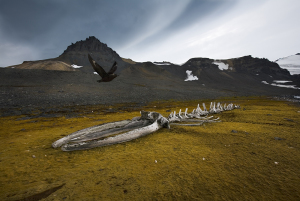 Sebastian Copeland
Sebastian Copeland
Arctica: The Vanishing North
Antarctica
The skeleton of this Humpback whale was reassembled by Commandant Cousteau in the Antarctica Peninsula. The moss forest it rests on is estimated to be 600 years old. The rapid warming of the Peninsula is introducing new vegetation to the area.
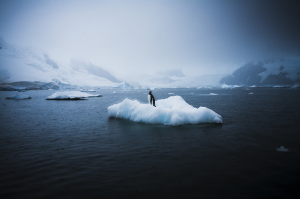 Sebastian Copeland
Sebastian Copeland
Arctica: The Vanishing North
Antarctica
This chinstrap penguin on a forlorn drifting piece of ice is an apt symbol for many declining rookeries in the Antarctic Peninsula. The warming of the southern oceans is having a direct impact on their food supply: krill. That decline could lead to a collapse of many subpopulations over the coming century.
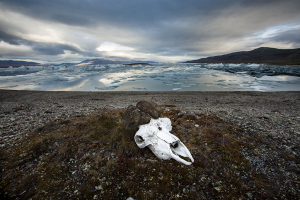 Sebastian Copeland
Sebastian Copeland
Arctica: The Vanishing North
Canada
This Musk Ox skull rests on a bed of moss on Ellesmere island in the Canadian Arctic. The Canadian high Arctic is undergoing substantial climate-related changes as well as habitat loss. Scavengers will polish the meat on the bone given the scarcity of protein in the high Arctic.
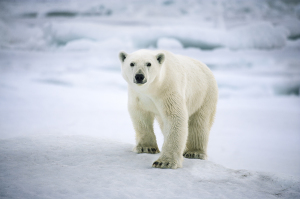 Sebastian Copeland
Sebastian Copeland
Arctica: The Vanishing North
Arctic
The Polar Bear (Urus Maritimus) is the apex predator of the Arctic, and the largest land-based predator. Climate change has challenged the bear’s habitat and hunting grounds on the sea ice. It has threatened many sub-populations while forcing migration of others towards areas with greater food concentration.
 Sebastian Copeland
Sebastian Copeland
Arctica: The Vanishing North
Canada
This young polar bear was likely the victim of starvation on Beechey Island, in the high Arctic. Mothers have been weaning their cub up to a year later in the last twenty years, as the young are least likely to nd sustenance in the lean months.
 Sean Gallagher
Sean Gallagher
Beijing – The Masked City
Beijing, China
A young couple, Ms. Lu and Mr. Li, hold hands during a walk through Beijing’s Olympic Park. “I’m pretty sad about this. It’s worse and worse”, explains Li. “I think the pollution is bad for our health. The PM2.5 damages our lungs [but] we don’t have any choice”, he laments. “I left China two and half years ago. Then it wasn’t so bad. I’ve been abroad. I know what’s good [air] and what’s bad. Young people care more than old people. We have more information. We know how bad it is.” PM2.5 reading – 218 – Very Unhealthy
 Sean Gallagher
Sean Gallagher
India’s Rising Tide of E-Waste
Kolkata, India
In the village of Sangrampur near Kolkata, young girls carry E-Waste which they will deliver to their families nearby who are involved in the recycling process. Lead, mercury, arsenic and other toxic elements are released in the breakdown process and those who handle the waste have little to protect themselves from the harmful materials.
 Sean Gallagher
Sean Gallagher
India’s Rising Tide of E-Waste
Kolkata, India
Three boys stand near E-Waste discarded at the side of a small pond in the village of Sangrampur near Kolkata. As electronic waste is broken down, harmful elements such as mercury, lead and arsenic leach into the soil and water resulting in the long-term poisoning of local resources.
 Simon Butterworth
Simon Butterworth
Blue Fields
Australia
Blue Fields was shot at the Useless Loop solar salt operation situated in Shark Bay, the westernmost point of mainland Australia. The crystallizers – shallow ponds in which the concentrated brine slowly evaporates, leaving a ‘crop’ of salt crystals – take on the appearance of an abstract watercolor. The crystallizers appear blue because they are re ecting the sky while the brushstroke patterns are the tracks left by the salt harvesting machine. Intense heatwaves occurring in Australia are posing a major threat to the life and ecosystem throughout Shark Bay.
 Simon Butterworth
Simon Butterworth
Blue Fields
Australia
The Shark Bay Solar Salt operation borders a mangrove ecosystem at the north end of the pond system. The mangrove creeks provide life-giving support to both terrestrial and marine life. In order to ensure that construction and operation of the salt eld will do no harm and have no impact on the living organisms, Shark Bay is constantly monitoring the ecosystems and has actually observed an increase in numbers of organisms.
 Stepan Rudik
Stepan Rudik
The Mannequin Factory
Istanbul, Turkey
Man working at the mannequin factory. During the realization of the project I noticed that the workers in factories do not have masks on their faces – every day they inhale the paint, and use no special equipment. There are no rules and no rights in such workplaces – the Mannequins are made of plastic that is not recycled, and the paint fumes not only affect the ill-equipped workers, but also pose an increasing threat to the toxins that enter our atmosphere.
 Stuart Chape
Stuart Chape
Coral reef lattice
Pacific Ocean
Coral reefs in the Pacific Ocean, and in the tropical waters of other seas around the world, support some of the richest marine biodiversity on the planet. This biodiversity provides food security and supports livelihoods and economic income through tourism. Coral reefs also have a vital role in maintaining coastal stability. Unfortunately they are also under severe threat from climate change, through increasing sea temperatures, sea level rise and ocean acidification.
 Stuart Chape
Stuart Chape
Eye of the sea
Tonga
The South Pacific Ocean contains more than 30,000 islands spread among 22 countries and territories. Most of the islands are the visible, emergent peaks of undersea volcanos, or rings of coral atolls supported by sunken volcanos. This photo shows a small uninhabited island in the Vava’u archipelago in the Kingdom of Tonga, surrounded by coral reefs. Such islands and reefs supports livelihoods and important seabird colonies, but they are under threat from rising sea levels, increased storm intensity and ocean acidi cation caused by climate change.
 Tom Jacobi
Tom Jacobi
Grey Matters
Deadvlei, Namibia
Deadvlei, or the “dead marsh” is a famous white clay pan which is located within the Namib-Naukluft Park in Namibia. It was formed after rainfall, when the Tsauchab river flooded, creating temporary shallow pools where the abundance of water all owed camel thorn trees to grow. When the climate dried up (some 900 years ago), drought hit the area, and sand dunes encroached on the pan, which blocked the river from the area. With Namibia declaring a drought emergency as of June 2016, the Deadvlei demonstrates in a hair-raising, yet fascinating way what climate change and the absence of water will do to a flourishing environment – virtually a glance into a despaired future.
 Tommaso Protti
Tommaso Protti
Bathtub Rings
São Paulo, Brazil
Fishermen along the Atibaia reservoir located 56 miles north of São Paulo. On the bridge’s pillars is visible the reduction of the water levels in the reservoir. The Atibaia is part of the Cantareira system, the city’s most important water storage facility that at that time was just 15 percent of its capacity. Cantareira served nearly half of the city’s population before the drought, but now supplies water to 5 million people as water managers turn to smaller reservoirs to relieve pressure on the system. Water levels at the main reservoir in Brazil’s largest city have more than doubled since the El Niño climate phenomenon ended a two-year drought, although industrialists and activists warn fresh shortages may be just a matter of time.
 Tommaso Protti
Tommaso Protti
São Paulo Water Crisis
São Paulo, Brazil
Since the drought began in 2014, São Paulo has struggled to provide water to its 20 million residents. Leading climate scientists sustain that the absence of rain that has dried up rivers and reservoirs in central and southeast Brazil in 2014 is a change brought about by a combination of the continuing deforestation of the Amazon, population growth, and global warming. The absence of the “ ying rivers” − the vapour clouds from the Amazon that normally bring rain to the centre and south of Brazil – would be at the heart of the current drought and water crisis.
 Turjoy Chowdhury
Turjoy Chowdhury
Life in Waste
Kolkata, India
An old woman is washing her hair and flies are all over her body as she lives just beside the mountain of waste at Dhapa waste dumping ground, Kolkata, India. This is the only waste dumping ground of the city, where the poorest and most neglected community lives. Most of them earn their bread and butter by picking rags, sorting out wastes. These people represent an extremely vulnerable and high-risk section of society, by virtue of its acute poverty, low levels of education, and an almost absolute disregard to the threat posed by entire gamut of diseases.
 Turjoy Chowdhury
Turjoy Chowdhury
Life in Waste
Kolkata, India
Local people and scavengers are passing time, sitting over the boundary wall of Dhapa waste dumping ground, which is the only waste dumping ground of the city. Dhapa waste dumping ground which is spread over 60 acres of land and started operations in 1987 has long outlived its utility. It was built with the capacity to accommodate the city’s waste for 15 years. Dhapa dumping ground can no longer take the burden of city’s 5,372 tons of urban municipal solid waste produced every day.
 Xuecong Lin
Xuecong Lin
Margin
China
I was born and grew up in a southern coastal city of China, witnessing the development, transformation as well as the increasing contradictions. Last year, I tried to use the most direct approach to take the photos along the southeastern coastal line. What I saw was completely different from that in my childhood as the result of the construction projects. All the things lost their identity, which made me feel the change here was so fast, including not only the environment, but also the customs, beliefs and families.
 Yuyang Liu
Yuyang Liu
Two Men Fishing in the Pond of Xian Village
Guangzhou, China
Two men were shing in the pond of Xian village, in the centre of Guangzhou city, Gu-angdong, China. Xian Village is in the center of Guangzhou city and surrounded by high buildings and large mansions, the epitome of China’s modern urbanization. Guangzhou is situated on the densely populated coastline where a rising sea level has become an alarming trend. Chinese research has estimated that a one-meter rise in sea level would inundate 92,000 square kilometres of China’s coast, thereby displacing 67 million.









































